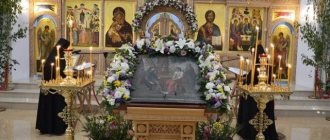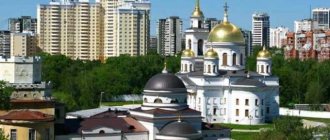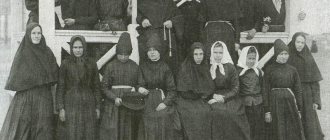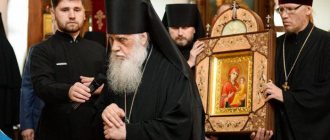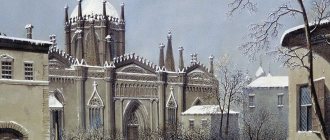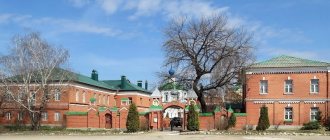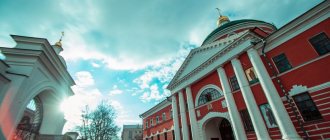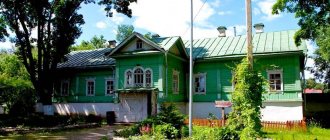Holy Bogolyubsky Monastery (Russia) - description, history, location. Exact address and website. Tourist reviews, photos and videos.
- Last minute tours
to Russia
1/
10
Holy Bogolyubsky Monastery
The largest of the monasteries in Vladimir and the surrounding area, the Holy Bogolyubsky Monastery is a witness to more than 8 centuries of Russian history, in the events of which it repeatedly played an important role. The uniqueness of the monastery is that it occupies secular buildings: in the 12th century, the residence of Prince Andrei Bogolyubsky was located here, and its main temple at that time - the Nativity Cathedral - was literally built into the complex of princely chambers.
Today, very little remains of the princely castle. The Holy Bogolyubsky Monastery is worth a visit to admire the works of the architect Ton, stand in the echoing silence of one of the largest churches in Russia - the Bogolyubsky Cathedral, wander along the banks of the half-overgrown monastery pond and, if you're lucky, hear the ringing of the magnificent bell ensemble.
The monastery houses the Bogolyubskaya Icon of the Mother of God, the first image of the Virgin Mary painted in Rus'. Before this, all icons were brought from Byzantium.
Bogolyubsky Castle
The Vladimir-Suzdal prince Andrei Yuryevich Bogolyubsky (the second son of the Rostov-Suzdal prince Yuri Vladimirovich Dolgoruky) around 1158 founded a country residence here - the “city of stones” Bogolyubovo, in which he also erected a temple in honor of the Nativity of the Virgin. Later sources explained the choice of place by the will of the Mother of God, either through the Vladimir Icon, or during its appearance to Prince Andrei (see Bogolyubskaya Icon of the Mother of God).
The ensemble of the princely residence included, in addition to temples, a two-story stone palace and a stone ciborium; the castle is surrounded by stone walls (see one of the reconstructions). “We don’t know of such a significant complex of white-stone buildings in pre-Mongol Rus',” states S.V. Zagraevsky. The castle was considered lost until the 1950s, until N.N. Voronin in 1954 discovered a transition to the choir and staircase tower, over which a hipped bell tower was built in the 18th century. From the white stone Church of the Nativity of the Virgin Mary, which collapsed in 1722, only the basement part has survived.
Bogolyubovo - history of foundation
According to legend, when Prince Andrei was traveling from Kyiv to the Suzdal-Rostov principality, he took with him an icon of the Mother of God. On the high bank of the Klyazma, the horses suddenly stopped and did not move again. The icon of the Mother of God seemed not to want to leave here. In addition, at night Andrei received a vision in which the Mother of God asked that a city be founded in this place. The prince fulfilled her wish and built a cathedral in honor of the Nativity of the Virgin Mary, as well as a castle named Bogolyubov, that is, beloved of God. Prince Andrey began to be called Bogolyubsky after the name of the residence built here.
At the same time, a more truthful reason for the founding of the city here was the desire of Prince Andrei Bogolyubsky to control the trade routes passing through Narva and Klyazma, since at that time the transportation of goods was carried out mainly by water.
Construction of the castle began in 1158, lasted seven years and ended in 1165 with the construction of the Church of the Intercession on the Nerl. The small temple is located at the confluence of the Nerl River and Klyazma, 1.5 km from Bogolyubovo. According to legend, the church is dedicated to the Russian holiday of the Intercession of the Blessed Virgin Mary and in memory of Izyaslav, the beloved son of the prince, who died in the battle with the Volga Bulgars.
History of the monastery
Prince Andrei was killed in his castle. It was probably to atone for this atrocity that the Bogolyubovo monastery was founded. N. N. Voronin suggested that the monastery on the territory of the castle was built under Andrei’s successors, at the beginning of the 13th century, but early information about the history of the monastery is very scarce and dates back to a much later time. It is not listed in the academic lists of ancient Russian monasteries.
According to the charter of Tsars John and Peter Alekseevich in 1687, the monastery became the Patriarchal House Monastery; in 1753 - synodal; later came under the jurisdiction of the Vladimir bishops; from 1882 until its closure it was managed by the vicars of the Vladimir diocese. When the states were established in 1763, the monastery was assigned the 3rd class, in 1872 - the 2nd, in 1891 - the 1st. A huge, heavy cathedral in honor of the Bogolyubskaya Icon of the Mother of God was erected in 1855-66. in the so-called “Russian-Byzantine style” according to the design of its founder, K. A. Ton.
In 1921-1923, the rector was the vicar of the Vladimir diocese of Kovrov, Bishop Afanasy (Sakharov). On June 3, 1923, the monastery was closed; On September 17 of the same year, the presidium of the Vladimir district executive committee decided to transfer all the property of the former monastery to the district and volost executive committees; By resolution of the same executive committee of December 21 and the Vladimir provincial government of January 8, 1924, the ensemble of the former monastery with all its property was transferred to the jurisdiction of the museum department.
Ticket prices to Bogolyubovo in 2021
The monastery is active. Entrance to the territory is free . When visiting the monastery in Bogolyubovo, you must follow the rules - you cannot enter the monastery in open clothes, and women must not wear a headdress.
In the Nativity Cathedral there is an exhibition “City of stones named after God-loving”; entrance to it is paid :
- for adults - 150 rubles
- For children under 16 years old - free
- For children over 16 years old and students - 100 rubles
Revival of monastic life
In 1991, part of the buildings was transferred to the monastics led by Schema-Abbot Nikodim. On January 14, 1997, by decision of the hierarchy, 60 sisters from the Zadonsk Spas-Preobrazhensky Monastery were transferred here; 2 monasteries arose: male and female. After this, the active revival of the monastery began.
The Cathedral of the Bogolyubskaya Icon of the Mother of God is completely plastered and has steam heating. Chandeliers are hung in the cathedral, the central one weighs about 2 tons, and nine more small side ones; The floor is paved with granite and marble, and the solea, the altar, the throne, the altar and the high place are paved with white marble. The restoration of the painting was completed, and in 2002 a new three-tier carved gilded iconostasis was made. Outbuildings were erected, an orchard was planted, cell buildings were restored. There are sewing, icon-painting, and carpentry workshops. Bells weighing 1050, 2500 and 8000 kg ring out in the surrounding area with festive ringing. A chapel and two fonts were built on the holy spring near the walls of the monastery.
The tradition of the religious procession with the Bogolyubsk Icon of the Mother of God, established in the 18th century, in memory of the miraculous cessation of prayers before the image of the terrible pestilence, has been revived. The religious procession from the city of Vladimir to the Holy Bogolyubsky Monastery takes place annually on July 1 - the day of the celebration of the Bogolyubsk Icon of the Mother of God.
With the help and resources of the Holy Bogolyubsky Monastery, the construction of a courtyard was completed in the Spas-Kupalische tract of the Sudogodsky district, located near the confluence of the Sudogda River and the Klyazma River. Since 2001, with the blessing of Archbishop Evlogiy of Vladimir and Suzdal, an entire monastery complex with a cell building and outbuildings was erected from scratch, a miraculous spring was installed, and the restoration of the Transfiguration Church has now been completed, in which services have been resumed.
How to get there?
Bogolyubsky Convent
Address: Sverdlovsk region, Krasnoufimsky district, Sarsy-Vtorye village, Pobedy street 41 Phone: +7 (982) 633-95-26, +7 (904) 174-83-33 Website: sarsy.rf Email: [email protected ] sarsy.rf VKontakte: vk.com/bogolubsky_mon
Coordinates for GPS navigator
56.234380, 57.983602
Sarsy-Vtorye village on the map
Bogolyubovo - brief description
The area of the built city was 3 hectares, it was surrounded by earthen ramparts and a white stone wall. In the center was the Cathedral of the Nativity of the Virgin Mary, connected by a passage to the Staircase Tower. This is the oldest surviving structure in the castle. From the tower there was a passage to the Palace of Prince Andrei. The facades of all the buildings were very elegant - decorated with bas-reliefs, frescoes and gilded copper details. The entire palace area was covered with slabs of white stone.
The fact that in the 12th century in Rus' a castle was built from white stone, and not from wood, was an exceptional case and many historians for a long time could not believe it (only excavations carried out in the 30s of the 20th century completely dispelled their doubts) .
To date, many historical buildings have been preserved on the territory of the monastery, including:
- Cathedral of the Nativity of the Blessed Virgin Mary, built in 1751 with the remains of walls and the foundation of a 12th-century temple
- The passage gallery and the unique Staircase Tower, in which Prince Andrei died at the hands of conspiratorial boyars in 1174
- Fragments of ancient ramparts.
Among the later buildings:
- Refectory Church of the Annunciation of the 17th century
- The five-domed Cathedral of Our Lady of Bogolyubskaya, built in the mid-19th century
- Housing of monastic cells of the 19th century
- Gate Church of the Assumption of the Blessed Virgin Mary, Holy Gate and Bell Tower of 1841
- Towers, fences and walls of the 19th century.
About the Bogolyubsk Icon of the Mother of God
July 1 is the day of celebration of the Bogolyubsk Icon of the Mother of God. This is a special shrine of the Vladimir-Suzdal land and one of the oldest Russian icons. This year the Orthodox Church celebrates 855 years since the appearance of the Most Holy Theotokos to the blessed Grand Duke Andrei Bogolyubsky. As you know, the icon was painted by order of the holy prince after a night vision of the Mother of God to him on the very place where the Bogolyubsky monastery was later founded by the prince and the city of Bogolyubov was built.This icon is the first painted in Rus', for until then all icons were brought from Byzantium. The Bogolyubskaya icon belongs to the iconographic type of Agiosoritissa, widespread in Greek church art of the 11th-12th centuries. The scroll in the hand of the Mother of God was added later; it brings the Bogolyubskaya icon closer to the iconography of the Mother of God Paraklisis (Intercessor). The creator of the icon was either a Greek icon painter or a Russian master who was well acquainted with contemporary Greek art.
On the icon, the Mother of God is depicted standing with her hands raised in prayer and her face turned to the Lord Jesus Christ who appeared to Her. In her right hand, the Mother of God holds a charter with Her prayer to Her Son: may He bless this place, chosen by Her. Above the image of the Most Pure Virgin are the marks of five icons that accompanied Saint Prince Andrew on his journey from Vyshgorod to the Rostov-Suzdal land: the Savior, the Mother of God (of Vladimir), St. Baptist John, Archangels Michael and Gabriel. The painted icon was solemnly transferred to the erected Church of the Nativity of the Blessed Virgin Mary. The celebration of the Bogolyubskaya Icon was established by the holy lord. Prince Andrei Bogolyubsky June 18, old style / July 1, new style For centuries - until the closure of the Bogolyubsk monastery in 1923, the icon was in the monastery and numerous miracles were performed from it. Currently, the ancient icon of the 12th century. located in the Vladimir-Suzdal Museum-Reserve.
During the Mongol-Tatar invasion of Batu Khan (1237-1240), the temple in honor of the Nativity of the Virgin Mary was burned, only the Bogolyubsky image of the Mother of God, by the will of God, was miraculously preserved in the fire unharmed. During the invasion of Tamerlane in 1395, the God-loving icon of the Mother of God, together with the Vladimir icon, was taken to Moscow to save Rus' from the Tatar hordes. On the day of the meeting of icons at the walls of Moscow, the “Mother of Russian Cities”, the Most Pure Mother of God appeared to Khan Tamerlane in a dream and commanded him to leave the Russian borders, and the Tatars fled in fear - Rus' was saved.
After this miracle, they decided to leave the Vladimir Icon in Moscow as God’s blessing and protection of the new capital, and the Bogolyubsk Icon was returned to Vladimir for the consolation of believers and placed again in the Bogolyubsk monastery. The memory has been preserved that in 1432 he led. Prince of Moscow Vasily Vasilyevich the Dark (1425-1462) placed a copy of the Bogolyubskaya icon in the Sretensky Church of his palace, and the pious Tsar Feodor Alekseevich Romanov (1676-1682) often visited the God-loving monastery and in 1680 donated his golden cross to the miraculous icon , decorated with precious stones. This cross with a dedicatory inscription later began to be depicted on many copies of the Bogolyubskaya icon.
In 1682, until the day of the celebration of the Bogolyubskaya Icon, the funeral of I. and A. Naryshkin, who were killed during the Streltsy uprising of the brothers of Queen Natalia Kirillovna, was postponed, and in 1684-1687. above the place of their burial in the Moscow VysokoPetrovsky Monastery, a church was built in honor of the Bogolyubskaya Icon (probably the first church with such a dedication); in 1690 it contained a copy of the Bogolyubsk Icon, brought by Tsar Peter from the Bogolyubsky Monastery. At that time, the Bogolyubskaya icon of the Kremlin Sretensky Cathedral was also considered a miraculous image. The legend about the icon in the village is connected with the special veneration of the Bogolyubskaya icon in the era of Peter I. Yuryevsky, Borovsky district, Kaluga province, donated by Peter to the steward B. Baturin, who asked to bless him with an image from the court church, as well as the legend about the appearance of the Bogolyubskaya Moscow Icon of the Mother of God, located above the Varvarsky Gate of Kitai-Gorod. The composition of the service of the Bogolyubsk Icon dates back to the turn of the 17th-18th centuries. and possibly connected with the construction of a temple in the Vysokopetrovsky Monastery. The oldest service list dates back to 1704.
There are three main versions of the Bogolyubskaya Icon of the Blessed Virgin Mary, which became widespread in the 17th-19th centuries.
The first is icons that accurately copy an ancient model, where the Mother of God is depicted with her hands raised in prayer to the Lord.
The second - the Mother of God is depicted together with the blessed prince Andrei Bogolyubsky kneeling before Her.
The third option is “Prayer for the People”, the Mother of God is depicted with a host of saints praying before Her - Moscow saints, noble princes, etc.
The Bogolyubsk Icon became especially famous for its miracles of healing and protection from the devastating epidemics of plague and cholera. In 1771, the city of Vladimir suffered a terrible disaster - an epidemic of pestilence - the plague (at that time Russia was at war with Turkey and through the troops the epidemic from the south quickly spread throughout Russia). All human efforts to stop the disease were in vain, many people died in terrible agony - this is how the whole of September 1771 passed. There was only hope for God's help - the people and clergy turned to the secular authorities with a request to bring an ancient shrine to the city of Vladimir - the Bogolyubskaya Icon of the Mother of God for a prayer service and religious procession. But the city authorities doubted for some time, intimidated by the assurances of the Protestant doctor, Mr. Fleischer, that the epidemic would allegedly intensify with the gathering of a large number of people. And yet the authorities gave in - on October 22, the icon was brought into Vladimir, nationwide prayers were held, and out of 200 sick people, only three died, the rest were healed, and in November the plague stopped altogether. The German doctor exclaimed: “My God, this is a miracle!”, and together with his family he converted from Lutheranism to Orthodoxy.
At the same time, residents of the city of Vladimir, through the spiritual consistory, submitted a petition to Catherine II for permission to hold annual religious processions with the Bogolyubskaya Icon of the Mother of God. Permission was received in 1772, and since then this pious tradition has been established in Vladimir.
The crowd of people on this day was huge - up to 18 thousand people took part in the procession. Already a few days before the holiday, all city hotels were crowded with visitors. On the day of the religious procession, no civil or educational institutions were open, public places and private shops were closed - the whole city lived with a single impulse - to worthily meet the Mother of God in Her miraculous Bogolyubsk icon. One can only imagine all the splendor of this procession: in front walked the cleric of the cathedral in a surplice, behind him were psalm-readers also in surplices and banner bearers in special embroidered caftans, who carried two lanterns, two crosses and forty banners, after them the common people carried miraculous icons, then The bishop's singers walked in pairs, followed by the clergy and the bishop. All city authorities and eminent dignitaries also took part in the procession, following the clergy. Next followed the countless crowd of ordinary people.
For a whole month, the Bogolyubskaya icon remained in the city - it was carried to all parish churches, as well as to private houses for prayer services. Over the course of three Sundays, they walked around the whole of Vladimir in a procession of the cross. And on the eve of June 18, Art. (July 1 N.S.) - the day of remembrance of the Bogolyubskaya Icon - she was returned to the monastery.
Based on the above, it is clear how great was the veneration of the Bogolyubskaya Icon of the Mother of God among the people. Of course, by faith, numerous miracles were performed from her, which were recorded in a special book kept at the monastery. One of these miraculous healings was described in the Vladimir Diocesan Gazette for 1877: “During the procession of the cross, the peasant Akim Fedorov and his family wished to bring warm prayers to the Queen of Heaven at his home, where St. icon. Akim Fedorov, during the usual prayer service, having prayed to the Queen of Heaven, venerated the icon himself and his family, then took his son (who could not walk due to weak legs), Ivan, 5 years old, venerated him too, and bent down to the ground under an icon so that they could carry it through him and his son, which was done. Then, getting up, Fyodor sat his son down at the house, and he himself went to see the saint off. icon of the Mother of God. At this time, the old man Ivan said to him: “Daddy, I’ll go with you.” The father answered: “Where are you going!” But Ivan got up and followed him, and from that time, thanks to the Queen of Heaven, he began to walk unhindered. This legend about the healing of the peasant son Ivan is attested in the submitted manuscript by the signature of two eyewitnesses of the miracle.”
Returning to the history of the procession, it can be noted that in the same year 1771, the residents of Moscow, who learned that the city of Vladimir was freed from the epidemic after the Bogolyubov Icon of the Mother of God was transferred there from Bogolyubovo, began to serve prayer services in front of the icon of the same name over the Varvarsky Gate. A large crowd of people attending a prayer service at the icon being lowered from the wall caused concern among the secular and spiritual authorities. Moscow Archbishop Ambrose (Zertis-Kamensky) ordered the prayer services to be stopped and, according to some sources, had the intention of removing the icon from the wall. This became the cause of popular unrest, which led to the murder of the Moscow Archbishop.
The next massive outbreak of cholera, also accompanied by popular unrest, occurred in Russia in 1830-31. Despite all the measures taken by the government to combat the epidemic, it was not possible to extinguish it with medical means alone. Since any illness is a visit from God, either as punishment for sins, or to admonish people, by order of Tsar Nicholas I, the text of a special prayer was sent to all churches of the Russian Empire for daily reading at the liturgy for deliverance from the scourge. In the fall of 1831, again by order of the Tsar, it was ordered to serve thanksgiving prayers in all churches of Russia for the healing and ending of the cholera epidemic.
At the height of this epidemic in the village. Teykovo, then belonging to the Vladimir province, the provincial leader of the nobility Andrei Petrovich Khmetevskoy left. He was from these places - the Khmetevsky estate was located in the village of Berezovik (now it is the Kovrovsky district). From May 25 to June 30, 1831, Khmetevskoy stayed in Teykovo, where an infectious diseases hospital was established under his leadership. At the same time, one of the copies of the Bogolyubskaya icon was delivered to Teykovo, after prayers were performed in front of it, the epidemic stopped. For the zeal and dedication shown in the fight against the cholera epidemic, Khmetevsky was declared royal favor. Since Andrei Petrovich was a parishioner of the Bogolyubsky Monastery and a special admirer of the Bogolyubsky Icon of the Mother of God, after his death in 1849 he was buried in the Bogolyubsky Monastery near the walls of the ancient Nativity of the Virgin Cathedral.
And miracles continued to be performed from the Bogolyubskaya Icon of the Mother of God and its numerous copies. In the same 1831, in the city of Usman, Tambov province, after prayers before the Bogolyubskaya Icon, the cholera epidemic also stopped. Well-known copies of the Bogolyubskaya Icon of the Mother of God, in addition to those listed above, are Tarussky in the Kaluga region, Zimarovsky in the Ryazan region, Uglich and many others, through prayers before which believers received healing from destructive epidemics - cholera epidemics of 1831, 1848, 1853 and 1870.
If in pre-revolutionary times religious processions with the Bogolyubskaya Icon of the Mother of God were the main source of income for the maintenance of the monastery, then after the revolution this was the only means of obtaining a livelihood. The Mother of God nourished those who served Her.
During the hungry years of the civil war, the icon was carried around the villages of the province. The peasants, knowing full well that they had nowhere to wait for help except from God, tried to be sure to accept the miraculous icon into their village. They could not allow such a shrine to pass by; they prayed that the Mother of God would not leave them without Her protection and patronage in such a turbulent time. The whole world collected money for the adoption of the icon. Sometimes we even had to sell our plots of summer mowing in order to have something to feed the monks who came with the icon, and to pay for prayer services. But not all residents were so pious. The situation at that time is reflected in a small article from the Suzdal regional newspaper.
The action took place in the village of Seltso, Yanev volost: “On March 22, a meeting of citizens of the village, for some political, and most importantly, for food reasons, decided not to accept the clergy of the Bogolyubsky Monastery accompanying the icon of the Mother of God. The next day, March 23, a meeting of citizens was again convened, at which the women appeared, led by Count. A. Tarasov, persistently demanded the acceptance of the icon and the clergy, and immediately organized their own separate meeting under the leadership of Tarasov and, choosing V. M. as collector, collected 2 rubles from those wishing to accept the priests. from home."
Processions with the Bogolyubsk Icon continued for several more years after 1917, although already in a semi-legal position. After the closure of the Bogolyubsky Monastery in 1923, the icon of the God-loving Mother of God was transferred to a group of believers in the village. Bogolyubov, but then confiscated to the museum, under whose jurisdiction it remains to this day. In the Bogolyubsky monastery, in the large cathedral, there is one of the miraculous copies of the God-loving icon, painted at the end of the 19th century.
The tradition of the procession with the Bogolyubsk Icon of the Mother of God, which takes place annually on the eve of the celebration of the Vladimir Icon of the Mother of God, has been revived. One of the copies of the God-loving icon is brought to the religious procession. On the evening of June 2, the sisters of the Bogolyubsk monastery with the clergy and pilgrims solemnly go with the icon to the Church of Sts. Equal-to-the-Apostles Constantine and Helena of the St. Alexeevsky Monastery in the city of Vladimir.
For a whole month, the Bogolyubskaya Icon, according to ancient tradition, remains in the city - it is carried in processions of the cross to all parish churches, and on the evening of June 30 - on the eve of the day of remembrance of the Bogolyubskaya Icon, it is returned to the monastery in a solemn procession of the cross.
About 4 thousand people from all over Russia gather for this religious procession, which takes place annually. The main cathedral church of the Bogolyubsk monastery, built in honor of this icon in 1866 at the expense of the Moscow merchants Alekseevs, accommodates 5 thousand people. It was founded in 1855, during celebrations dedicated to the 700th anniversary of the founding of the monastery. Currently, both the temple and the monastery have been completely restored from ruins, and the restoration of the paintings of the cathedral church has also been completed. All this has been done before our eyes literally over the last 10-12 years thanks to the tireless efforts of the rector of the monastery churches and the confessor of the monastery, Archimandrite Peter (Kucher) and the sisters. The monastery is one of the spiritual and cultural centers of modern Russia.
Isn’t it time to do the most important thing - to restore historical justice and return the ancient God-loving icon from the museum to the cathedral church of the Bogolyubsk monastery, for which it was actually built?! In the Bogolyubsky Cathedral you can place an ancient shrine and create the proper conditions for its preservation. You cannot keep a lamp under a museum cover, but you must place it on a “candlestick, so that it may shine for everyone,” as the Gospel says. The future of Russia depends on our reverence for our shrines, on our attitude towards faith and salvation.
I would like to finish this story about the ancient Bogolyubsk icon with the words from the sermon of the confessor of the Holy Bogolyubsky convent, Archimandrite Peter (Kucher): “ Therefore, today, perhaps more than ever before, in our last, apocalyptic time of the general attack on the Russian Orthodox Church by all the forces of the transworld evil, we must repent and ask the Most Holy Theotokos for help. We must pray for healing from another terrible disease - the plague of godlessness, atheism and apostasy. For before our eyes there is taking place an assault on Holy Orthodoxy unprecedented in the history of the Church in terms of power, scale and variety of forms.
Through the prayers of the Most Holy Theotokos, may the Lord protect the Russian land, strengthen the Orthodox faith and revive the former glory of our Fatherland. Most Holy Theotokos, save us!
»
Voice of truth. 1918 No. 8.
Cathedral of the Nativity of the Blessed Virgin Mary
The Nativity Cathedral was especially elegant; it contained a lot of gold and silver utensils. The floor, covered with copper tiles, shone like gold, and the choir was covered with majolica (ceramic tiles), painted with patterns and colors, and also depicting monster animals. The doors of the temple were bound with gold, and the walls and vault were covered with frescoes. The columns were also unusual for that time, round in shape, decorated on top with large “crowns” with foliate patterns (capitals), which indicates the involvement of Italian architects in the construction.
In front of the cathedral there was a ciborium (a canopy supported by eight columns). In its center there was a white stone bowl for the blessing of water. The dome of the ciborium glittered with gilding.
At the end of the 17th century, the cathedral was in good condition, however, in 1722, Abbot Ippolit decided to increase the width of the windows to make the temple brighter, as a result the building collapsed. It was possible to preserve only the Staircase Tower and the passage to it; this was the most revered place - Prince Andrei died here. Now, you can see that the Bell Tower tent of a later period - the 18th century - was built on the historical Staircase Tower.
The new Nativity Church was built in 1751; at its base, the walls and pillars of the ancient cathedral of the 12th century have been preserved.
How to get there[edit]
From Moscow to Bogolyubovo you can get from Kursky station by train (on schedule) or by bus (from 6-00 to 20-00 with an interval of every half hour) daily to Vladimir.
Further, by city routes, it’s about 6 km to Bogolyubovo (to the monastery): on almost any bus, to the VHZ (Vladimir Bakery Plant) and there you can already use a much larger number of routes.
Buses also run from Moscow to Vladimir from Shchelkovsky station.
Highway E22/M7, center of the village. Bogolyubovo
Address[edit]
601270, Vladimir region, Suzdal district, Bogolyubovo village

